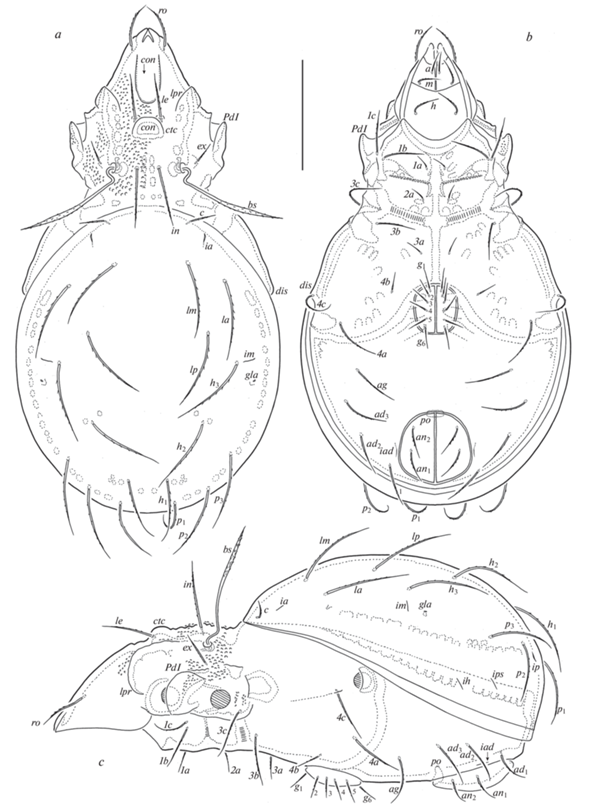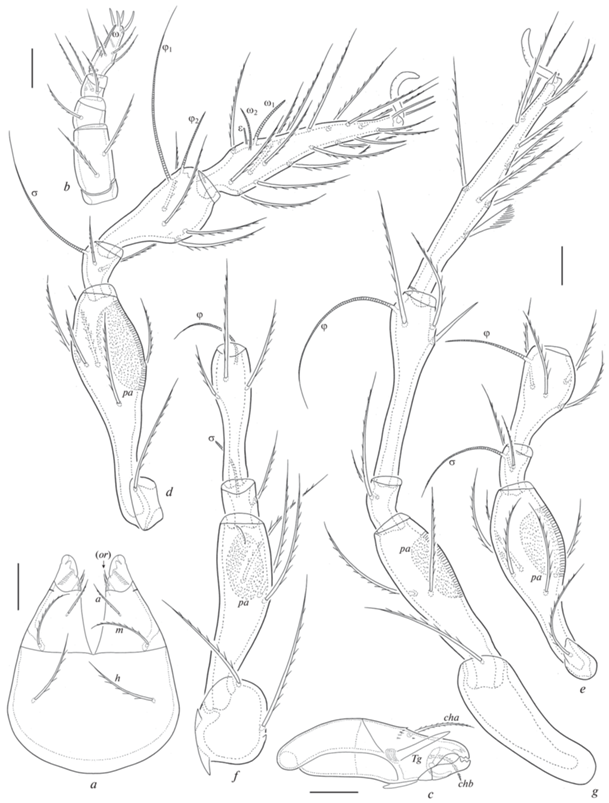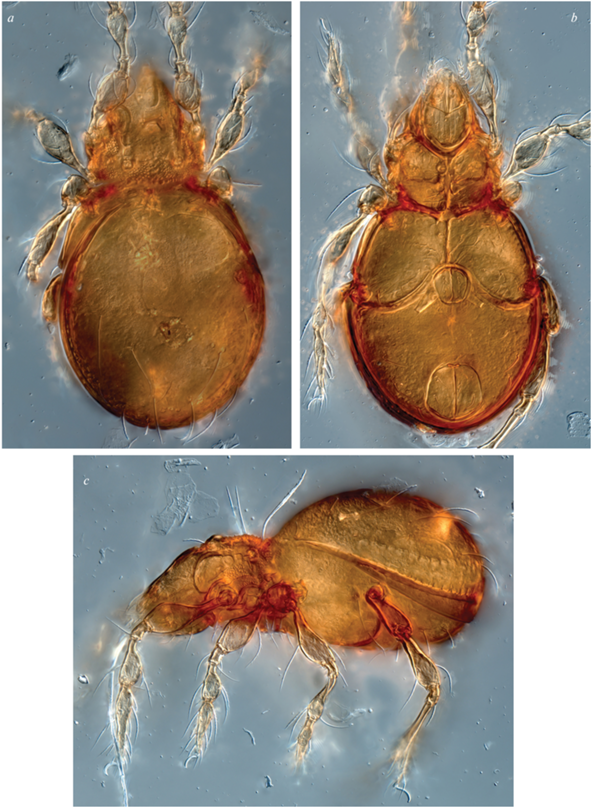Зоологический журнал, 2022, T. 101, № 6, стр. 616-622
Amboroppia bayartogtokhi gen. n., sp. n. (Acari, Oribatida, Oppiidae, Arcoppiinae) from Bolivia
S. G. Ermilov a, *, J. Starý b, **
a Tyumen State University
625003 Tyumen, Russia
b Biology Centre of the Czech Academy of Sciences, Institute of Soil Biology
CZ-37005 České Budějovice, Czech Republic
* E-mail: ermilovacari@yandex.ru
** E-mail: jstary@upb.cas.cz
Поступила в редакцию 30.04.2021
После доработки 5.05.2021
Принята к публикации 6.05.2021
- EDN: HFZJPS
- DOI: 10.31857/S0044513422060046
Аннотация
We propose a new oribatid mite genus, Amboroppia gen. n. (Oribatida, Oppiidae, Arcoppiinae), with Amboroppia bayartogtokhi sp. n. as type species. The genus is described based on adults from Bolivia. It can be distinguished from similar genera (Mimoppia Balogh 1983 and Similoppia Mahunka 1983) by the structure of the bothridial seta (spindle-shaped, narrowly elongate, dilated in mediodistal part, without cilia) atypical of Arcoppiinae, as well as by the position of the lamellar seta (before the translamella).
The oribatid mite family Oppiidae (Acari, Oribatida, Oppioidea) comprises 1073 species (with 53 subspecies) distributed across 131 genera (Subías 2021). During our study of Bolivian oppiids, we found a new genus of the subfamily Arcoppiinae. Herein we describe and illustrate Amboroppia gen. n., with A. bayartogtokhi sp. n. as type species, based on adults.
In Bolivia, the family Oppiidae has been studied briefly: only a few species have been recorded (e.g. Hammer, 1958; Balogh, Mahunka, 1969; Ermilov, Niedbała, 2013).
MATERIALS AND METHODS
Specimens. The specimens of the new species were kindly provided by the Institute of Soil Biology, České Budějovice, Czech Republic. The type material is distributed among two institutions: the Senckenberg Museum of Natural History, Görlitz, Germany (SMNH); and the Tyumen State University Museum of Zoology, Tyumen, Russia (TSUMZ).
Observation and documentation. Specimens were mounted in lactic acid on temporary cavity slides for measurement and illustration. The body length was measured in lateral view, from the tip of the rostrum to the posterior edge of the notogaster. Notogastral width refers to the maximum in dorsal aspect. Lengths of body setae were measured in lateral aspect. All body measurements are presented in micrometers. Formulas for leg setation are given in parentheses according to the sequence trochanter–femur–genu–tibia–tarsus (famulus included). Formulas for leg solenidia are given in square brackets according to the sequence genu–tibia–tarsus. Drawings were made with a camera lucida using a Leica transmission light microscope “Leica DM 2500”.
Terminology and conventions. Morphological terminology used in this paper mostly follows that of F. Grandjean: see Travé and Vachon (1975) for references, Norton (1977) for leg setal nomenclature, and Norton and Behan-Pelletier (2009) for overview.
Abbreviations and notations. Prodorsum: ctc = costular-transcostular complex; con = concavity; ro, le, in, bs, ex = rostral, lamellar, interlamellar, bothridial, and exobothridial seta, respectively; lpr = lateral prodorsal ridge. Notogaster: c, la, lm, lp, h, p = notogastral setae; ia, im, ip, ih, ips = notogastral lyrifissures; gla = opisthonotal gland opening. Gnathosoma: a, m, h = subcapitular setae; or = adoral seta; ω = palp solenidion; cha, chb = cheliceral setae; Tg = Trägårdh’s organ. Epimeral and lateral podosomal regions: 1a–c, 2a, 3a–c, 4a–c = epimeral setae; PdI = pedotectum I; dis = discidium. Anogenital region: g, ag, an, ad = genital, aggenital, anal, and adanal seta, respectively; iad = adanal lyrifissure; po = preanal organ. Legs: ω, φ, σ = leg solenidia; ɛ = leg famulus.
TAXONOMY
Family Oppiidae Sellnick 1937
Subfamily Arcoppiinae Balogh 1983
Genus Amboroppia Ermilov et Starý gen. n.
Type species Amboroppia bayartogtokhi Ermilov et Starý sp. n.
Generic diagnosis. Adult. Size. Length about 400. Integument. Prodorsum partially densely tuberculate. Prodorsum. Rostrum tripartite. Costula and transcostula forming arch-like ridge. Medioanterior part of prodorsum with longitudinally elongate concavity. Interbothridial and postbothridial tubercles absent. Interbothridial muscle sigillae present. Rostral, lamellar and interlamellar setae well developed, setiform; le located before translamella. Bothridial seta very long, spindle-form, narrowly elongate dilated in mediodistal part, without cilia. Notogaster. Without humeral tooth and crista. Ten pairs of setiform setae, c distinctly shorter than others, la inserted posterolaterally to lm. Gnathosoma. Subcapitulum diarthric. Adoral seta present. Palp setation: 0-2-1-3-8(+1ω); solenidion long, bacilliform, pressed to the tarsus surface. Chelicera chelate-dentate. Epimeral and lateral podosomal regions. Epimeral border IV present. Epimere III + IV longitudinally elongated. Epimeral setal formula: 3-1-3-3; setae setiform. Epimeral and ventrosejugal tubercles absent. Pedotectum I represented by small lamina. Discidium slightly developed. Anogenital region. With six pairs of genital, one pair of aggenital, two pairs of anal, and three pairs of setiform adanal setae. All adanal setae lateral to anal plate, distance between ad3–ad3 longer than ag–ag and ad2–ad2. Adanal lyrifissure parallel and close to anal aperture. Legs. Setae l '' and v' present on tarsus I, l '' present on tarsus II. Tarsus II with two solenidia. Juvenile instars. Unknown.
Differential diagnosis. Among Arcoppiinae, Amboroppia gen. n. is similar to the genera Mimoppia Balogh 1983 and Similoppia Mahunka 1983 from the Ethiopian and Neotropical regions (see Balogh, 1983; Mahunka, 1983; Subías, 2021). The three aforementioned genera are similar in having a tripartite rostrum, an arch-like costular-transcostular complex, and long dorsal notogastral setae. They are also similar in the absence of long apical branch(es) on the bothridial head. However, the new genus differs from Mimoppia and Similoppia in the atypical (for Arcoppiinae) morphology of bothridial seta (spindle-form, narrowly elongate, dilated in mediodistal part, without cilia versus pectinate in Mimoppia and globular or lanceolate in Similoppia). Also, in Amboroppia, the lamellar seta is located before translamella (versus behind translamella in Mimoppia and Similoppia). In addition, in Similoppia, adanal seta ad1 is in postanal position (versus in lateral position in Amboroppia) and Similoppia’s epimere III + IV is comparatively short (versus longitudinally elongate in Amboroppia).
Etymology. The generic name refers to the Amboró National Park, near which the type material was collected + ‘oppia’, a common suffix for generic names in Oppiidae.
Amboroppia bayartogtokhi Ermilov et Starý sp. n. (Figs 1–3)
Fig. 1.
Amboroppia bayartogtokhi sp. n., adult: a – dorsal view, b – ventral view (legs not shown), c – lateral view (gnathosoma and legs not shown). Scale bar 100 µm.

Fig. 2.
Amboroppia bayartogtokhi sp. n., adult: a – subcapitulum, ventral view; b – palp, right, antiaxial view; c – chelicera, left, paraxial view; d – leg I, right, antiaxial view; e – leg II, without tarsus, right, antiaxial view, f – leg III, without tarsus, right, ventral view, g – leg IV, left, antiaxial view. Scale bar (μm): a, c–g – 20; b – 10.

Fig. 3.
Amboroppia bayartogtokhi sp. n., adult, microscope images: a – dorsal view, b – ventral view, c – lateral view.

Material. Holotype (♀) and two paratypes (2♀♀): Bolivia, Espejillos environs near Amboró National Park, 17°53′22″ S, 63°26′48″ W, 562 m a.s.l., sifting leaf litter in rain forest, 29.XI.2009 (collected by B. Greenway).
The holotype is deposited in the SMNH; two paratypes are deposited in the TSUMZ. All specimens are preserved in ethanol with a drop of glycerol.
Diagnosis. Body size: 398–415 × 223–232. Prodorsum partially densely tuberculate. Tripartite rostrum with short median tooth and longer, connected forwards lateral parts. Costular-transcostular complex small, arch-like. Prodorsal setae long, setiform, barbed; in longest, ex shortest and thinnest. Bothridial seta very long, spindle-form, narrowly elongate dilated in mediodistal part, barbed. Notogastral setae setiform, barbed; c short, others long. Epimeral and anogenital setae setiform, barbed. Discidium rounded.
Description. Measurements. Body length: 398 (holotype), 398, 415 (paratypes); notogaster width: 223 (holotype), 223, 232 (paratypes).
Integument (Figs 1a, 1c; 3a, 3c). Body color light brown. Body surface microporose (visible only under high magnification in dissected specimens, ×1500). Dorsal and lateral (between bothridium and acetabula I–III) parts of prodorsum densely tuberculate (diameter of tubercles up to 4).
Prodorsum (Figs 1a, 1c; 3a, 3c). Rostrum tripartite; median tooth short, lateral parts long, connected forward tooth (illusory, median tooth sunken). Costulae and transcostula forming small arch-like ridge. Region between rostrum and costular-transcostular complex with elongate concavity; additional oval concavity located behind complex. Rostral (41–45), lamellar (41–45), interlamellar (57–61), and exobothridial (30–32) setae setiform, barbed; ex thinner than others. Bothridial seta (114–118) spindle-form, narrowly elongate dilated in mediodistal part, barbed. Interbothridial region with three pairs of muscle sigillae. Interlamellar and postbothridial tubercles absent. Longitudinal row, comprising several muscle sigillae, present in front of the bothridium. Lateral prodorsal ridge strong, arch-like.
Notogaster (Figs 1a, 1c; 3a, 3c). Anterior border convex medially. Ten pairs of notogastral setae (c, 22–24; others 73–77) setiform, barbed. Opisthonotal gland opening and all notogastral lyrifissures distinct.
Gnathosoma (Figs 2a–2с). Subcapitulum longer than wide (86–94 × 61–65). Subcapitular setae m (28–32) and h (32–36) setiform, shortly ciliate; a (20–24) setiform, barbed. Adoral seta (8) setiform, thin, smooth. Palp (49–53) with typical setation: 0-2-1-3-8(+1ω). Postpalpal seta (4) spiniform, roughened. Chelicera (86–94) with two setiform, barbed setae (cha, 24–28; chb, 16–20).
Epimeral and lateral podosomal regions (Figs 1b, 1c; 3b, 3c). Epimeral border IV well developed, semi-oval. With typical epimeral setal formula: 3-1-3-3. All epimeral setae (1a, 2a, 3a, 4b, 20–24; others 45–53) setiform, barbed; 1b and 1c located close to each other. Discidium rounded.
Anogenital region (Figs 1b, 1c; 3b, 3c). Genital (20–24), aggenital (45–53), adanal (45–53), and anal (24–32) setae setiform, barbed. Adanal lyrifissure distinct.
Legs (Figs 2d–2g; 3c). Claw of legs roughened on dorsal side. Trochanter III with two or three posterior teeth. All femora with large ventral porose area. Formulas of leg setation and solenidia: I (1-5-2-4-20) [1-2-2], II (1-5-2-4-16) [1-1-2], III (2-3-1-3-15) [1-1-0], IV (1-2-2-3-12) [0-1-0]; homology of setae and solenidia indicated in Table 1.
Table 1.
Leg setation and solenidia of adult Amboroppia bayartogtokhi sp. n.
| Leg | Tr | Fe | Ge | Ti | Ta |
|---|---|---|---|---|---|
| I | v' | d, (l), bv'', v' | (l), σ | (l), (v), φ1, φ2 | (ft), (tc), (it), (p), (u), (a), s, (pv), l '', v', (pl), ɛ, ω1, ω2 |
| II | v' | d, (l), bv'', v' | (l), σ | (l), (v), φ | (ft), (tc), (it), (p), (u), (a), s, (pv), l '', ω1, ω2 |
| III | l ', v' | d, l ', ev' | l ', σ | l ', (v), φ | (ft), (tc), (it), (p), (u), (a), s, (pv) |
| IV | v' | d, ev' | d, l ' | l ', (v), φ | ft '', (tc), (p), (u), (a), s, (pv) |
Etymology. The species name is dedicated to our friend and colleague, acarologist Prof. Dr. Badamdorj Bayartogtokh (National University of Mongolia, Ulaanbaatar, Mongolia), for his extensive contributions to our knowledge of the taxonomy and ontogeny of oribatid mites.
Список литературы
Balogh J., 1983. A partial revision of the Oppiidae Grandjean, 1954 (Acari: Oribatei) // Acta Zoologica Academiae Scientiarum Hungaricae. V. 29. № 1–3. P. 1–79.
Balogh J., Mahunka S., 1969. The scientific results of the Hungarian soil zoological expeditions to South America. 12. Acari: Oribatids from the materials of the second expedition. III // Acta Zoologica Academiae Scientiarum Hungaricae. V. 15. № 3–4. P. 255–275.
Ermilov S.G., Niedbała W., 2013. Contribution to the knowledge of the oribatid mite fauna of Bolivia, Zambia, Cambodia and Vietnam, with descriptions of two new species (Acari, Oribatida) // Spixiana. V. 36. № 1. P. 9–19.
Hammer M., 1958. Investigations on the oribatid fauna of the Andes Mountains. I. The Argentine and Bolivia // Det Kongelige Danske Videnskabernes Selskab Biologiske Skrifter. V. 10. № 1. P. 1–129.
Mahunka S., 1983. Oribatids from the Eastern Part of the Ethiopian Region (Acari) III // Acta Zoologica Academiae Scientiarum Hungaricae. V. 29. № 4. P. 397–440.
Norton R.A., 1977. A review of F. Grandjean’s system of leg chaetotaxy in the Oribatei (Acari) and its application to the family Damaeidae // In: Dindal D.L., editor. Biology of oribatid mites. Syracuse, SUNY College of Environmental Science and Forestry. P. 33–61.
Norton R.A., Behan-Pelletier V.M., 2009. Oribatida // A Manual of Acarology (TX): Lubbock, Texas Tech University Press. P. 430–564.
Subías L.S., 2021. Listado sistemático, sinonímico y biogeográfico de los ácaros oribátidos (Acariformes: Oribatida) del mundo (excepto fósiles). 16ª actualización. Online version accessed in March 2021, 532 p. http://bba.bioucm.es/cont/docs/RO_1.pdf
Travé J., Vachon M., 1975. François Grandjean. 1882–1975 (Notice biographique et bibliographique) // Acarologia. V. 17. № 1. P. 1–19.
Дополнительные материалы отсутствуют.
Инструменты
Зоологический журнал


